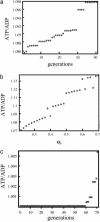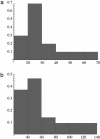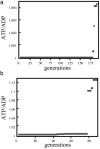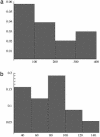Advantages of external periodic events to the evolution of biochemical oscillatory reactions
- PMID: 12893876
- PMCID: PMC187823
- DOI: 10.1073/pnas.1633771100
Advantages of external periodic events to the evolution of biochemical oscillatory reactions
Abstract
We compare, by calculations on a simple model of glycolysis, the evolutionary development of oscillatory reaction mechanisms in the presence and absence of external periodic events, such as an oscillatory or constant influx of glucose in an open reaction system. The chosen model has autonomous oscillations for given choices of the parameters of the feedback loops responsible for the oscillations, and for a given range of the total adenylate pool concentration. We change first one, then two of the parameters, so that there are no autonomous oscillations, and then vary these parameters with a genetic algorithm method in which the parameters are represented by binary strings that evolve by selection, crossover, and mutations; the optimization goal is the attainment of a high ATP/ADP concentration ratio in the system. This goal is taken to provide evolutionary advantages and is shown to be achieved more quickly in the presence of external periodic events, rather than constant influx of glucose. The results suggest the possibility of the enhanced evolutionary development of oscillatory biological reactions at shores where waves impinge on rocks and bring nutrients periodically. Measurements have shown that animals and plants grow more rapidly in the presence of such wave action than in its absence.
Figures






Similar articles
-
Temporal self-organization in biochemical systems: periodic behavior vs. chaos.Am J Physiol. 1983 Oct;245(4):R478-83. doi: 10.1152/ajpregu.1983.245.4.R478. Am J Physiol. 1983. PMID: 6312816
-
Oscillations and control features in glycolysis: numerical analysis of a comprehensive model.Proc Natl Acad Sci U S A. 1981 May;78(5):2952-6. doi: 10.1073/pnas.78.5.2952. Proc Natl Acad Sci U S A. 1981. PMID: 6454892 Free PMC article.
-
Robustness of glycolysis in yeast to internal and external noise.Phys Rev E Stat Nonlin Soft Matter Phys. 2011 Aug;84(2 Pt 1):021913. doi: 10.1103/PhysRevE.84.021913. Epub 2011 Aug 8. Phys Rev E Stat Nonlin Soft Matter Phys. 2011. PMID: 21929026
-
Ageing, oscillations and efficiency.Biosystems. 1995;36(1):1-5. doi: 10.1016/0303-2647(94)01491-o. Biosystems. 1995. PMID: 8527692 Review.
-
Oscillatory enzyme reactions and Michaelis-Menten kinetics.FEBS Lett. 2013 Sep 2;587(17):2778-84. doi: 10.1016/j.febslet.2013.07.031. Epub 2013 Jul 23. FEBS Lett. 2013. PMID: 23892075 Review.
Cited by
-
Effect of Indolic-Amide Melatonin on Blood Cell Population: A Biophysical Gaussian Statistical Analysis.Molecules. 2018 Jun 7;23(6):1378. doi: 10.3390/molecules23061378. Molecules. 2018. PMID: 29875344 Free PMC article.
-
Prebiotic competition and evolution in self-replicating polynucleotides can explain the properties of DNA/RNA in modern living systems.BMC Evol Biol. 2020 Jun 26;20(1):75. doi: 10.1186/s12862-020-01641-4. BMC Evol Biol. 2020. PMID: 32590933 Free PMC article.
-
Cancer stem cell theory and the warburg effect, two sides of the same coin?Int J Mol Sci. 2014 May 19;15(5):8893-930. doi: 10.3390/ijms15058893. Int J Mol Sci. 2014. PMID: 24857919 Free PMC article.
-
Kinetic laws, phase-phase expansions, renormalization group, and INR calibration.Proc Natl Acad Sci U S A. 2009 Apr 21;106(16):6465-70. doi: 10.1073/pnas.0809855106. Epub 2009 Apr 6. Proc Natl Acad Sci U S A. 2009. PMID: 19366671 Free PMC article.
References
-
- Rapp, P. E. & Berridge, M. J. (1981) J. Exp. Biol. 93, 119–132.
-
- Goldbeter, A. (1997) Biochemical Oscillations and Cellular Rhythms: The Molecular Bases of Periodic and Chaotic Behavior (Cambridge Univ. Press, Cambridge, U.K.).
-
- Richter, P. H. & Ross, J. (1980) Biophys. Chem. 12, 285–297. - PubMed
Publication types
MeSH terms
Substances
Grants and funding
LinkOut - more resources
Full Text Sources

